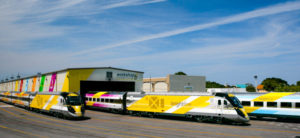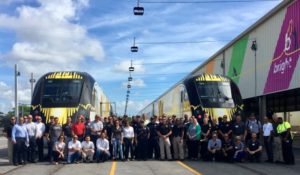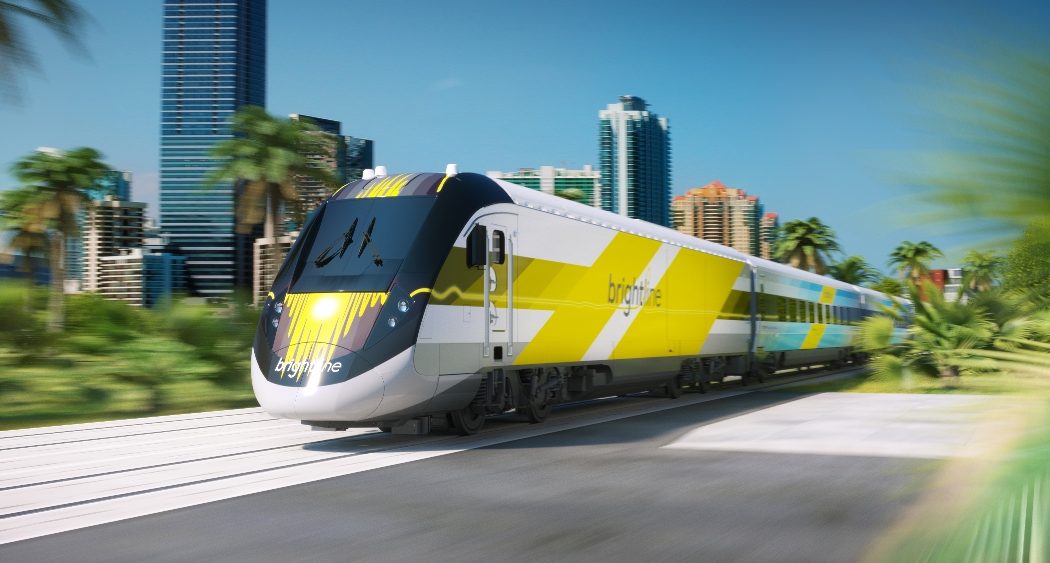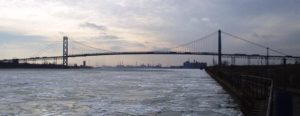In May of 2017, a private company took delivery of two new trains that will provide service in South Florida later this year. Named BrightGreen and BrightOrange after the signature color schemes of the train cars, the sets were delivered simultaneously after a 3052-mile journey across the country from Siemens Rolling Stock manufacturing hub in Sacramento, California.
Their arrival was scheduled in celebration of National Train Day, taking place on Saturday, May 13. Combined, the two Brightline trains are approximately 1,000 feet long, each foot symbolizes the 1,000 Siemens employees who helped build them.
 They are 100 percent Buy America compliant, manufactured with components from more than 40 different U.S. suppliers across 20 states. BrightGreen and BrightOrange now join BrightBlue and BrightPink at Workshop b, Brightline’s 12-acre railroad operations facility in West Palm Beach.
They are 100 percent Buy America compliant, manufactured with components from more than 40 different U.S. suppliers across 20 states. BrightGreen and BrightOrange now join BrightBlue and BrightPink at Workshop b, Brightline’s 12-acre railroad operations facility in West Palm Beach.
All this private investment in high-speed rail might be confusing to those who remember the Obama administration’s $8 billion federal stimulus designed to incentivize states to compete for federal transportation grants in a way that catalyzed a national high-speed rail network.
That failed, but in 2011, after Florida Governor Rick Scott killed plans for a public high-speed rail connector, All Aboard Florida’s parent company, Florida East Coast Industries (FECI), stepped up to create the state’s first high-speed rail.
When the Brightline launches in late 2017, it will be America’s first new private train system in over three decades. And it will be America’s first-ever private high-speed rail. Florida, Texas, and California are three states in desperate need of high-speed rail. All are car-addicted, all have major cities separated by long distances, and all lack significant passenger rail service. Sure enough, private rail initiatives are underway in both Texas and California.
The first phase of the Brightline only connects Miami, Fort Lauderdale and West Palm Beach, but it’s real. It’s happening. Hopefully, Orlando, Tampa, and maybe even distant Jacksonville will follow. Jacksonville wouldn’t make economic sense as a destination, but it might be the perfect terminus for a necklace of revitalized cities along Florida’s entire east coast.
 Why would private developers invest in something that’s traditionally the domain of the public sector? It’s not just for the rail itself, but for the effect this new connectivity has on the communities and properties they reach. Thus, they don’t just purchase right-of-ways: they also purchase the properties whose value will skyrocket the day a new transit connection is announced.
Why would private developers invest in something that’s traditionally the domain of the public sector? It’s not just for the rail itself, but for the effect this new connectivity has on the communities and properties they reach. Thus, they don’t just purchase right-of-ways: they also purchase the properties whose value will skyrocket the day a new transit connection is announced.
In the old days, when rail was built by governments—or by unallied private firms—such profits were made primarily by bribing public clerks to reveal new permit applications.
Now, in what might be called a design-build-revitalize model, it’s all under one roof. A single company designs and builds the rail system, and then redevelops the land around the stations. This new connectivity thus stimulates the repurposing and renewing of many older structures, and remediation of long-vacant brownfields.
The real estate redevelopment aspect is the only thing—other than public subsidies—that can make capital-intensive private investments in rail work. Not surprisingly, All Aboard Florida’s parent company, Florida East Coast Industries (FECI) just happens to include Flagler, a full-service commercial real estate company.
As has been documented many times here in REVITALIZATION, the three most powerful universal economic revitalizers are water, transit (especially rail), and residents. When consciously (and conscientiously) combined with a 3Re Strategy of community revitalization based on repurposing, renewing, and reconnecting a community’s natural, built, and socioeconomic assets, the results are often breathtaking.
Of course, private investment in high-speed rail is old hat in Europe, where (especially in France) rail has long been built by public-private partnerships (P3). The U.S. has traditionally been rather bad at P3s. Due mostly to politicaly corruption, they often devolve into outright privatization.
For a prime example of how 100% private ownership can fly in the face of the public good, one only has to look at the Ambassador Bridge fiasco. It’s an old, undersized, overcrowded suspension bridge connecting Detroit, Michigan, with Windsor, Ontario, Canada.
When it came time to build a new, larger bridge to handle the growing level of international trade, the highly-litigious (and thus unnamed here) private individual who owns the Ambassador sued the government, alleging unfair competition against his toll bridge. A combination of high-powered lawyers and purchased politicians stifled progress for decades. It was only resolved when Canada finally gave up on the Americans’ ever getting their act together, and offered to pay the full cost of the new bridge.
“Today marks another milestone as we welcome two additional trainsets to Workshop b,” said Dave Howard, Brightline’s CEO. “The arrival coincides with National Train Day, which is a chance to celebrate these powerful machines and the rich history passenger rail has played in our country. Brightline is a shining example of U.S. manufacturing and innovation while setting a world-wide standard of service in the hospitality and transportation industries.”
Workshop b is now home to four trains with BrightRed, the fifth trainset, arriving late-June. Workshop b provides over 120 jobs, serving as the on-duty location for train crews as well as the site where trains are maintained, cleaned and stored. There are four tracks within the facility, two of which are covered and one featuring a 500-foot long maintenance pit underneath for performing daily inspections and service.
 Brightline aims to provide a much-needed, hospitality-driven alternative to South Florida’s congested roadways. Each train abounds with innovations and comfortable features including automatic level boarding, wide aisles exceeding ADA compliance, multiple outlets for devices and complimentary, robust Wi-Fi, powered by multiple antennas in every car.
Brightline aims to provide a much-needed, hospitality-driven alternative to South Florida’s congested roadways. Each train abounds with innovations and comfortable features including automatic level boarding, wide aisles exceeding ADA compliance, multiple outlets for devices and complimentary, robust Wi-Fi, powered by multiple antennas in every car.
All Aboard Florida develops innovative multi-use community spaces that incorporate a unique transportation service. The company is building Brightline and dynamic mobility-centric urban centers in Miami, Fort Lauderdale and West Palm Beach. All Aboard Florida is a part of Florida East Coast Industries (FECI), parent company of successful operations in real estate, transportation and infrastructure.
FECI is one of Florida’s oldest and largest full-service commercial real estate, transportation, and infrastructure companies. Headquartered in Coral Gables, Florida, FECI dates back over a century. Henry Flagler first established a predecessor company in 1892, which became a pioneer in the development of Florida’s eastern coast.
Today, FECI continues to transform Florida as the parent company to four distinct business lines, including the afore-mentioned Flagler real estate company; All Aboard Florida, the United States’ first privately owned and operated intercity passenger rail system; Flagler Global Logistics, an integrated logistics company; and Parallel Infrastructure, a leader in third-party Right of Way (ROW) investments and management services. FECI is owned by private equity funds managed by affiliates of Fortress Investment Group, LLC.
All images courtesy of All Aboard Florida.


